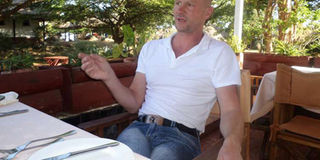Quality fingerlings, feeds will put cash in fish farmers’ wallets

Marius Them-Enger, the CEO of Aller Aqua Kenya Limited, a fish feeds manufacturing company. PHOTO | ELIZABETH OJINA | NATION MEDIA GROUP
What you need to know:
- As any other farming venture, fish needs good management, with the farmer paying attention to all aspects of the venture, from pond constructing to sourcing fingerlings and marketing.
- With catfish you can make sausages, samosas and fillets for more money.
- Using high quality feeds has a direct impact on the Food Conversion Ratio (how much feeds it takes for single fish to hit 1kg).
- Unlike the catfish which is a carnivore, tilapia fish is a vegetable eater.
Fish farming is undergoing major transformation as farmers embrace cages and make their own feeds to cut costs. Elizabeth Ojina spoke to Marius Them-Enger, the CEO of Aller Aqua Kenya Limited, a fish feeds manufacturing company on the changes that are taking place and how to put more money in farmers pockets
What are the key things one should consider before going into fish farming?
As any other farming venture, fish needs good management, with the farmer paying attention to all aspects of the venture, from pond constructing to sourcing fingerlings and marketing.
Then there are feeds, which can make up to 90 per cent of the cost of doing the business if not well managed. One should also look out for the genetic material of the fingerlings.
If you have bad fingerlings, the fish will grow slow heaping you with losses.
Many fish farmers are now making their own feeds. Is that a threat to feed manufacturers like you?
First I would say that if you want to be a good farmer, don’t compromise on the quality of feeds.
It is better one buys quality feeds and end up with good stock than make own and produce fish that cannot be sold in the market.
With fish, as any other farming venture, one needs the highest quality of feeds and fingerlings. If you need to make feeds you need proper knowledge.
The fact is using high quality feeds has a direct impact on the Food Conversion Ratio (how much feeds it takes for single fish to hit 1kg).
If you offer fish quality feeds, they should be able to attain a kilo of biomass with 1.3 to 1.4kg of mass of feeds in six months.
Cage fish farming is gaining currency among farmers living around Lake Victoria. What is your take on the new method of farming?
One needs a licence before engaging in the farming. They should also watch the depth of the lake, which has to be 8 to 12 metres and the cages should not be placed on navigation routes.
Most farmers keeping fish in cages feed them twice a day believing that they scavenge in the waters, which is wrong. Unlike the catfish which is a carnivore, tilapia fish is a vegetable eater.
A good farmer feeds his tilapia 10 times in a day. It’s not about more feeding but the frequency to obtain all the proteins and nutrients to make the fish grow at maximum speed throughout the day.
Again, if you put cages in the wrong places there’s a higher chance of getting diseases.
What are the common challenge fish farmers are facing and how can they overcome them?
Lack of the right knowledge on fish farming is a common challenge. Some of the farmers get into the venture without understanding the market, therefore, incurring losses.
Most produce fish without knowing the buyers and the production cost. You need to get the market before starting your fish farm.
There is also need to explore market beyond our borders. Tilapia is white meat, thus, a very healthy meal that is much sought.
If Kenyan farmers keep fish according to set standards, then we can export the produce in plenty. Farmers also need to embrace value addition. With catfish for instance, you can make sausages, samosas and fillets.




